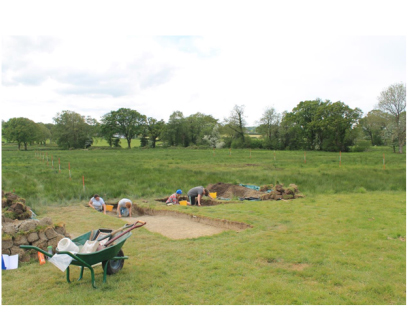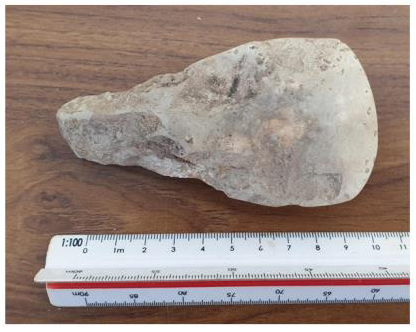The Remarkable Neolithic of West Wales is Explored
University Staff and Students Find Neolithic Artefacts
Staff and students from the University of Wales Trinity Saint David (UWTSD), Lampeter campus have uncovered evidence of New Stone Age activity in western Wales including the discovery of a stone axe that would have been a prized possession some 4,000 years ago.
The stone axe find was made during an archaeological dig at Llanllyr in Talsarn, Ceredigion county. The dig is part of a programme of undergraduate fieldwork, enabling students to gain “hands on” experience and to practice field techniques. Excavations have been centred around low mounds surrounded by marshland, areas that are believed to have formed dry ground in the past and as such, they are key places to study for signs of early human habitation. These “islands” of raised, dry ground appear to have been the focus of activity in the Neolithic period (between four and six thousand years ago), when people left behind traces of their presence in the form of flint tools and other artefacts.
Staff and Students Working at the Archaeological Site

Picture credit: University of Wales Trinity Saint David (UWTSD)
Trenches Dug to Explore the Deposition of Material
Exploratory trenches were dug at the site and in one, a ground stone axe was discovered. This rare artefact very probably had a wooden handle when in use thousands of years ago. The axe would have taken many hours of skilled labour to shape, academics have expressed surprise that such an object was abandoned in this landscape. The team from the University are also investigating the surrounding area using boreholes to recover samples suitable for reconstructing the ancient vegetation and to provide further data to help date the age of the stone tool finds.
The Flint Stone Axe Found at the Site

Picture credit: University of Wales Trinity Saint David (UWTSD)
Field Work Experience – An Important Teaching Aid
Joint leader of the dig team, Dr Martin Bates, a geoarchaeologist at the University of Wales Trinity Saint David commented:
“Running an excavation like this is an important part of our teaching here at Lampeter and giving our students the opportunity to gain the skills an archaeologist needs is very important. When we began our excavations, we did not anticipate finding Neolithic artefacts so this is a bonus for the team. Hopefully, we can come back next year with a new group of students and continue our investigation of this important piece of Ceredigion’s history.”
Lucky Student
Second-year student Joe Neal was the lucky person who uncovered the stone axe. The archaeology undergraduate student stated:
“It’s a great find for us, I couldn’t have hoped to find anything better. This is my first dig and the first time I have found anything, so this is great.”
Dr Ros Coard, Senior Lecturer in Archaeology at UWTSD, added:
“The University of Trinity Saint David has run excavations at the Llanllyr site over a number of years but mostly found later medieval material, so to find a much deeper pre-history is exciting and broadens our understanding of the Aeron Valley and this part of Ceredigion. It is a most unusual and unexpected find certainly warranting further exploration of the area.”
Everything Dinosaur acknowledges the assistance of a press release from the University of Wales Trinity Saint David in the compilation of this article.
To read about a New Stone Age jawbone with a beeswax filling: Neolithic Dentists.
To read an article about the mapping and recording of high altitude, ancient Stone Age artwork: High Rise Archaeology.
Visit the Everything Dinosaur website: Everything Dinosaur.

